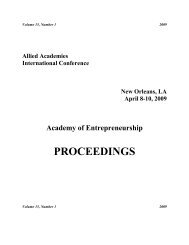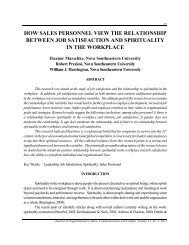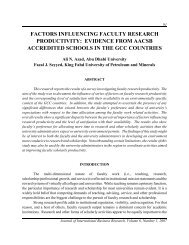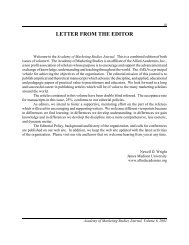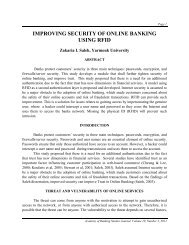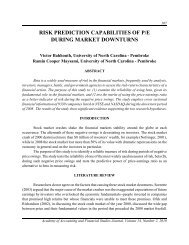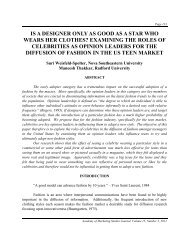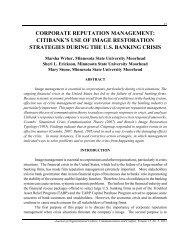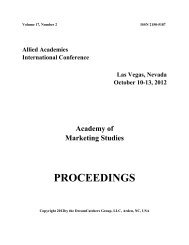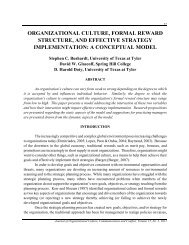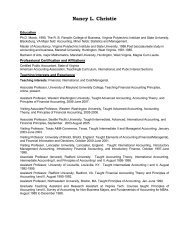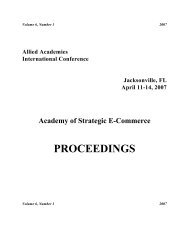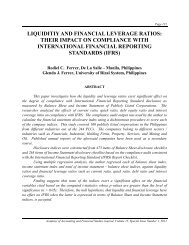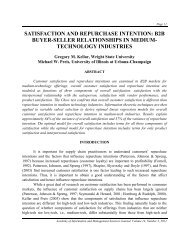AOCCC - Allied Academies
AOCCC - Allied Academies
AOCCC - Allied Academies
You also want an ePaper? Increase the reach of your titles
YUMPU automatically turns print PDFs into web optimized ePapers that Google loves.
page 40<br />
<strong>Allied</strong> <strong>Academies</strong> International Conference<br />
Workplace Weight Discrimination<br />
LITERATURE REVIEW<br />
Workplace weight discrimination is surprisingly common as a study found that 54% of<br />
respondents experienced weight stigmatization from co-workers or colleagues, 43% from<br />
employers or supervisors, and 25% experienced overall job discrimination (Puhl & Brownell,<br />
2006). Weight discrimination may be explained by attribution theory. According to attribution<br />
theory, negative judgments of obese individuals surface among employers, co-workers, and<br />
society largely due to a belief that obesity can be controlled by individuals who are obese<br />
(Crandall & Martinez, 1996). These negative opinions are linked to a just world belief which<br />
implies that people with negative characteristics should be treated in accordance to that<br />
characteristic (Crandall, et al., 2001). The outcome for the obese is generally workplace weight<br />
discrimination at every phase in the employment process from selection to termination<br />
(Roehling, et al., 2008).<br />
Coping<br />
So how does one deal with perceived weight discrimination? Consistent with a study by<br />
Puhl and Brownell (2006), we propose that individuals utilize coping mechanisms. Lazarus and<br />
Folkman (1985) offer the transactional stress model which proposes three processes for<br />
understanding stress; primary appraisal, secondary appraisal, and coping. Coping is the process<br />
of executing a response after one has perceived a threat (primary appraisal) and evaluated<br />
potential responses (secondary appraisal) (Lazarus, 1966). Puhl and Brownell (2006) discovered<br />
that most frequently those experiencing weight stigma in the form of job discrimination coped<br />
via positive behaviors such as being nice, ignoring the situation, and dieting. However, based on<br />
a study by Diamond et. al. (2008), the two approaches to coping examined in this study are<br />
active coping and behavioral disengagement because of their focus on workplace discrimination.<br />
“Active coping is the process of taking active steps to try to remove or circumvent the stressor or<br />
to ameliorate its effects, for example initiating direct action, increasing one’s efforts” (Carver, et<br />
al., 1989, p. 268). Conversely, behavioral disengagement refers to reducing effort to overcome a<br />
stressor, even to the point of abandoning goals which are being hindered by the stressor (Carver,<br />
et al., 1989).<br />
Diamond et al. (2008) suggest that victims of discrimination may benefit more from<br />
disengagement coping because the victim is unlikely to be able to be removed from the<br />
environment and behavioral disengagement allows them to avoid the discrimination, deny its<br />
existence, or just plain accept it (Carver, et al., 1989; Diamond, et al., 2008). Alternately, if the<br />
victim chose to actively cope, there is a likelihood of lower career success because of retaliation<br />
as in cases of sexual harassment. This argument is valid for victims of weight discrimination.<br />
Orlando, 2011<br />
Proceedings of the Academy of Organizational Culture, Communications and Conflict, V.16(1)



